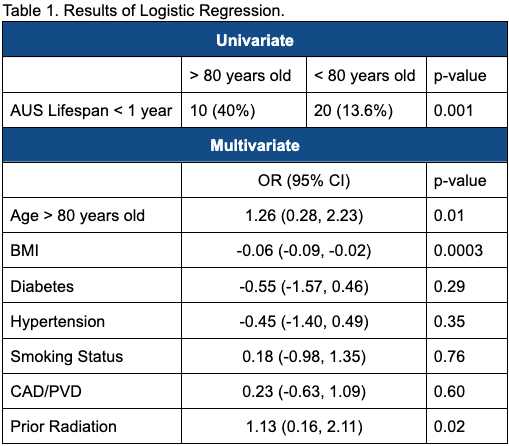The Artificial Urinary Sphincter and the Octogenarian
Siddharth Marthi, MD, Rachel Greenberg, MD, Aparna Ashok, MD, Kennon Miller, MD, Madeline Cancian, MD.
The Warren Alpert Medical School of Brown University, Providence, RI, USA.
BACKGROUND: The artificial urinary sphincter (AUS) is the gold standard in surgical management of stress incontinence. While AUS can confer significant long-term quality of life improvements, the duration of AUS efficacy and complication rate can vary significantly between patients and is dependent, at least partly, on patient-related risk factors. Previous studies have identified several factors which would predispose to complications, including certain medical comorbidities as well as exposures such as pelvic radiation. However, little is known about how these factors specifically impact older patients. In this study, we sought to assess the duration of AUS efficacy and complications in AUSs implanted in patients over the age of 80.
METHODS: A retrospective review of all AUS placements placed at a single institution between January 1st, 2011 and January 1st, 2021 in patients over the age of 21 was performed. The lifespan for each AUS was measured as the number of days between date of implantation and date of revision, explantation, or the study end date. We compared the lifespans of 1st, 2nd, and 3rd AUS in patients above and below 80 years old. We also evaluated the prevalence of medical comorbidities in these two age groups. Data was analyzed using t-tests and logistic regression.
RESULTS: 97 patients met study criteria and were included in the analysis. Across all implanted AUSs, the mean AUS lifespan was 1015 days in patients over 80 versus 1821 days in patients under 80 (p = 0.02). Patients who were over the age of 80 at time of implantation were more likely to have an AUS with a lifespan of under one year when compared to patients below the age of 80 at time of implantation (p = 0.001). On multivariate analysis, age above 80 (p = 0.01), history of radiation (p = 0.02), and lower BMI (p = 0.0003) were associated with an AUS lifespan of under one year, whereas diabetes (p = 0.29), hypertension (p = 0.34), smoking status (p = 0.76), and coronary artery disease/peripheral vascular disease (p = 0.60) were not (Table 1).
CONCLUSIONS:
Short AUS lifespans of <1 year were statistically more likely to occur in men over the age of 80, compared to those under 80. On multivariate analysis, history of radiation and decreased BMI were also found to be associated with an AUS lifespan of under one year. There was a trend towards shorter mean lifespan of AUS for men over the age of 80 whether initial or redo AUS, though this did not reach statistical significance. Further study is needed with larger sample size to further elucidate this relationship. Our findings emphasize the importance of consideration of age when deciding on stress incontinence management. 
Back to 2022 Abstracts


